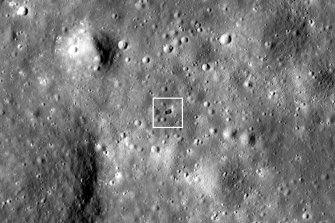A mystery rocket crashed into the moon – and no one (on Earth) is owning up
NASA scientists are baffled by a mystery spacecraft that crashed into the moon, creating two large craters.
The rocket has been tracked through space since 2015, but no one has claimed it. It was travelling at more than 5 kilometres a second when it hit the lunar surface on March 4 this year – and new images by NASA’s Lunar Reconnaissance Orbiter show that the impact was unlike anything they had seen before.
NASA’s Lunar Reconnaissance Orbiter spotted the rocket impact site on the Moon, which crashed into the Lunar surface on March 4 2022.Credit:NASA/GSFC/Arizona State University.
“Surprisingly, the crater is actually two craters, an eastern one (18m diameter) superimposed on a western one (16m diameter),” scientists from NASA and Arizona State University wrote in a post.
“The double crater was unexpected and may indicate that the body had large masses at each end. Typically a spent rocket has mass concentrated at the motor end; the rest of the rocket stage mainly consists of an empty fuel tank. Since the origin of the rocket body remains uncertain, the double nature of the crater may indicate its identity.”
Amateur astrologists first pointed the finger at SpaceX, but then recalculated it was likely to be from a 2014 Chinese lunar mission (Chang’e 5-T1). China has contested this, saying that booster had “safely entered the Earth’s atmosphere and was completely incinerated”.
Before and after images of the rocket crash. Taken Feb 28 and May 21, respectively.Credit:NASA/GSFC/Arizona State University
Bill Gray, an astronomer who created software that tracks objects in space, had to work backwards and compute an approximate orbit, because although China announces and televises its launches, it does not reveal routes.
“I’m 99.9 per cent sure it’s the China 5-T1,” he told the BBC. He had previously thought it was a SpaceX booster.
There are hundreds of pieces of debris on the surface of the moon, as well as lunar landers and astronauts’ waste in ziplock bags. Rocket boosters from the Apollo missions left a number of craters some 40 yards wide on the moon, while in 2019, Israel’s crashed Beresheet spacecraft scattered debris on the lunar surface.
At least 47 NASA rocket bodies have created “spacecraft impacts” on the moon, according to 2016 data from Arizona State University. However, its scientists said: “No other rocket body impacts on the moon created double craters.”
Japan, South Korea, Russia, India and the United Arab Emirates aim to send missions to the moon in the next year, while the US plans to land the first woman there in 2024.
The Telegraph, London
Most Viewed in World
From our partners
Source: Read Full Article
